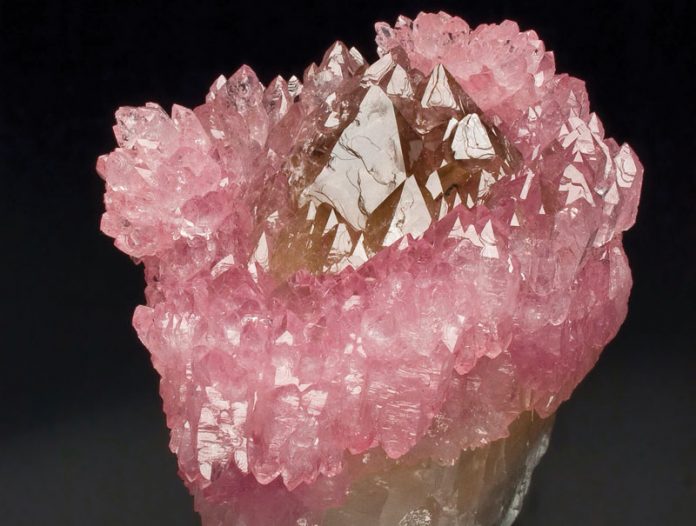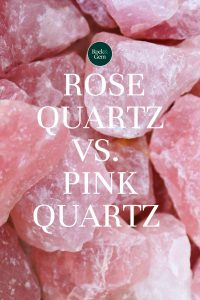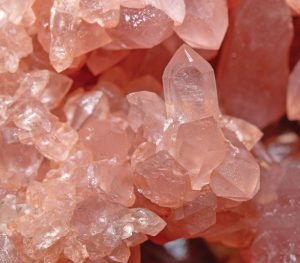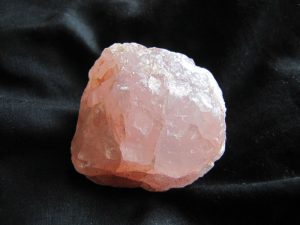
Rose quartz ranks high among the most attractive and familiar of the many color varieties of quartz. Its delicate pink color, soft translucency, and affordability make it a popular gemstone.
Pink quartz is a mu ch lesser-known variety of quartz. While similar to rose quartz in color, it differs markedly in structure, degree of transparency, origin of color, occurrence, rarity, and cost.
Both rank a 7 on the Mohs scale of hardness.
Rose Quartz

Rose quartz always occurs in massive form without crystal faces or terminations. Translucent and with uniform color distribution, it is found mainly in the core zones of granite pegmatites.
Mineralogists had traditionally attributed the color of rose quartz to traces of titanium and, to a lesser extent, iron and manganese. These impurities were thought to distort the crystal lattice, causing it to reflect and transmit red wavelengths of light which the human eye perceives as varying shades of pink.
More recent studies have shown the pink color is because of fibrous inclusions. After dissolving rose quartz from several different sources in hydrofluoric acid, researchers have recovered residues of flaky, pink-colored nanofibers, most consisting of dumortierite and other aluminum borosilicates.
Although these nanofibers make up only about one-tenth of one percent of the overall weight of rose quartz, they are highly reflective and create both its characteristic pink color and its soft translucency. Usually aligned along the axes of quartz’s hexagonal crystals, these inclusions also explain the six-rayed asterism that appears in the star variety of rose quartz.
Pink Quartz
Pink quartz, a pink macrocrystalline variety of quartz, was discovered in pegmatites at Rumford, Maine, and first described in mineralogical journals in 1938. But these specimens attracted little attention from mineralogists or collectors at the time, Initially, they were assumed to be a rare, atypical subvariety of rose quartz.

Wikimedia Commons
Then in 1959, pegmatite miners in Brazil’s gemstone-rich Minas Gerais state discovered clusters of beautifully developed, terminated, hexagonal quartz prisms. These crystals had water-clear transparency and a pink color that was similar, but not identical to, the color of rose quartz. When these specimens appeared on the collector markets of Europe and the United States, the limited supply was snapped up by both collectors and mineralogists.
Mineralogists soon learned that the color of pink quartz, unlike that of rose quartz, is created when some silicon ions within the quartz crystal lattice are replaced by trivalent aluminum ions and pentavalent phosphorus ions. This partial replacement renders the lattice susceptible to distortion from the energy of natural geophysical radiation, creating color centers that form when radiation displaces phosphorus ions from their normal lattice positions, leaving voids that trap electrons. When white light boosts these trapped electrons to higher energy levels, they return to their normal levels by releasing excess energy as visible light that we perceive as pink or pale red.
The Differences
The inclusions in massive rose quartz inhibit crystal development, while the absence of inclusions in pink quartz ensures normal crystal development and a high degree of transparency. In addition, the color of pink quartz is often zoned and most intense near the crystal terminations. The color of crystalline pink quartz also fades slowly with prolonged exposure to sunlight, while the color of massive rose quartz is stable. Pink quartz is sometimes intermixed with citrine, the golden-yellow color variety of quartz.

Steve Voynick
The formation of pink quartz requires unusual and complex chemical and physical conditions that include partial ionic replacement within the quartz lattice, sufficient geophysical radiation to create color centers and enough space to permit crystal growth. Because these conditions don’t often occur together, pink quartz, unlike rose quartz, is rare, costly and found in only a few localities. A fine specimen of pink quartz can cost hundreds of dollars.
Another difference between the rose and pink subvarieties is size. Rose quartz often occurs in large masses; pink quartz is found only as crystals an inch or two in size. Given these collective differences, the term pink quartz is now used to differentiate crystalline pink quartz from massive rose quartz.
In general usage, the descriptive color terms pink and rose are often imprecise. Rose quartz is sometimes sold as pink quartz and vice versa. Also, massive rose quartz is frequently cut into hexagonal prisms for use in pendants; while these may appear to be natural crystals of pink quartz, their translucency immediately identifies them as rose quartz. Pink quartz is almost always retained as a specimen in its natural form.
This story about rose quartz vs. pink quartz appeared in Rock & Gem magazine. Click here to subscribe. Story by Steve Voynick.















